Trees Birds Mammals Fish Amphibians Reptiles
Wild Algarve
Bookshop
Lepiota clypeolaria (Bull.) P. Kumm. - Shield Dapperling
Phylum: Basidiomycota - Class: Agaricomycetes - Order: Agaricales - Family: Agaricaceae
Distribution - Taxonomic History - Etymology - Toxicity - Identification - Reference Sources
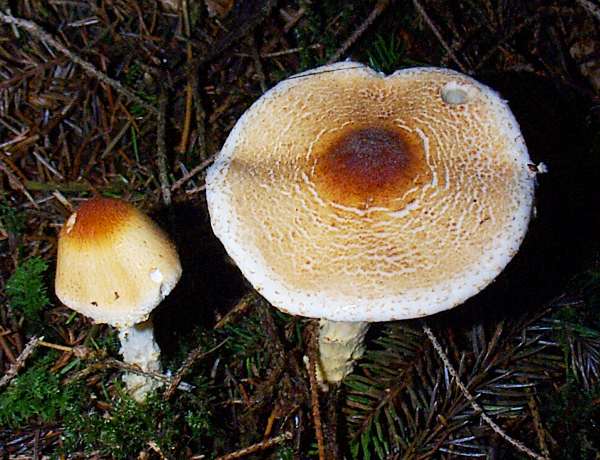
Lepiota clypeolaria, the Shield Dapperling, is one
of the larger Lepiota species, many of which are poisonous. This woodland mushroom could easily be mistaken for one of the edible Agaricus species that occur in wooded areas. The white and unchanging gill colour should be enough to ring warning bells, and its unpleasant odour is yet another of the features that should help foragers avoid an unpleasant mistake.Thje woolly vellum flakes on the stem are another macroscopic feature that helps identify this toxic toadstool.
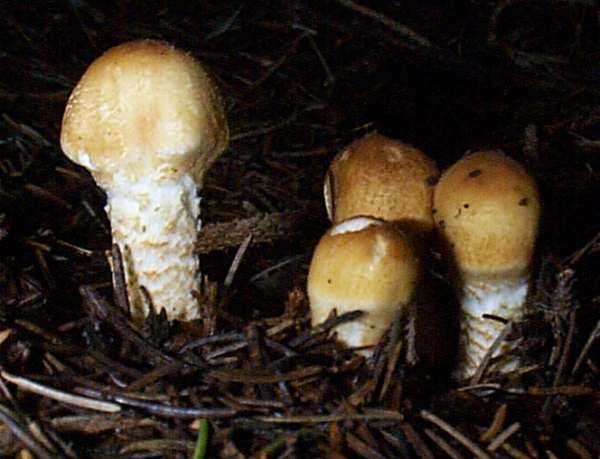
Distribution
Infrequent in Britain, this poisonous mushroom occurs throughout Europe but it is more common in central and southern European countries.
Taxonomic history
The basionym of this species dates from 1789, when French mycologist Jean Baptiste Francois (Pierre) Bulliard described it and gave it the binomial name Agaricus clypeolarius. It was German mycologist Paul Kummer who, in 1871, transferrd this species to the genus Lepiota, at which point it acquired its currently-accepted scientific name Lepiota clypeolaria.
Synonyms of Lepiota clypeolaria include Agaricus clypeolarius Bull., Agaricus colubrinus Pers., Lepiota colubrina (Pers.) Gray, Lepiota clypeolaria var. minor J. E. Lange, Lepiota clypeolaria var. ochraceosulfurescens Locq., and Lepiota ochraceosulfurescens Locq. ex Bon.
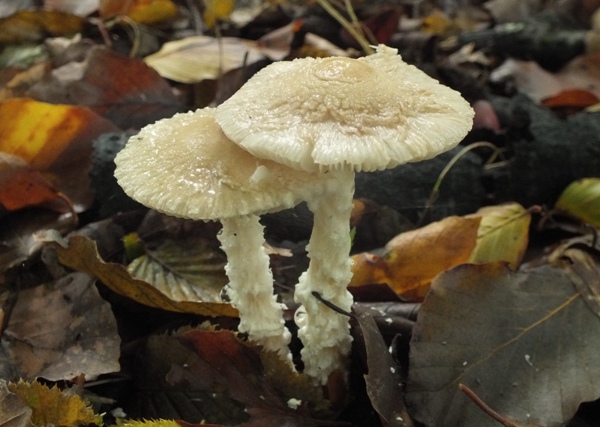
Etymology
Lepiota, the genus name, comes from the Latin word lepis, meaning scale - a reference to the scaly caps of this group of agarics. The specific epithet clypeolaria is a reference to the round shield-like shape of the caps of these mushrooms. (The Latin word for a round shield is clipeus or clypeus.)
Toxicity
Until recently, dapperlings were more commonly referred to in Britain as parasols - a confusion that may have added to the risk of poisoning, as the large Macrolepiota species, commonly known as parasols, are good edible mushrooms. The Shield Dapperling, like most if not all small woodland dapperlings, is a seriously poisonous mushroom and so great care is essential to avoid accidentally including it when gathering mushrooms to eat.
Identification guide
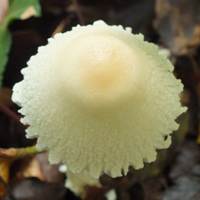 |
Cap
Initially bell-shaped expanding to a broad convex form with a low umbo; white or cream with a pale brown or ochre central region that eventually cracks into small, fibrillose pale- to mid-brown scales. The cap margin is fringed with white flakes of the partial veil. Cap diameter at maturity ranges from 2 to 6cm. |
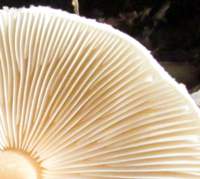 |
Gills
The free, crowded gills are white,
darkening only very slightly with age.
Cheilocystidia
Mainly fusoid. |
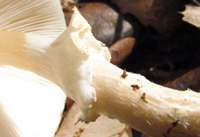 |
Stem
Cylindrical with a slightly clavate base, the stem has a silkily fibrillose surface above a white fragile pendent ring and is covered in cotton-wool like veil fragments below; the stem flesh is whitish.
Typically 3 to 10mm in diameter, the stems vary between 5 and 12cm in height. |
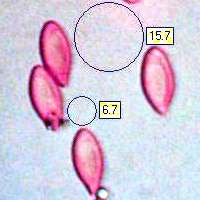 |
Spores
Amygdaloid-ellipsoidal or fusoid, smooth, 11-16 x 5-7μm; dextrinoid.
Spore print
White. |
Odour/taste |
Unpleasant odour; mild taste. |
Habitat & Ecological role |
Saprobic, solitary or in very small groups in mixed, coniferous and broadleaf woodland, usually on rich soil. |
Season |
August to November in Britain and Ireland. |
Similar species |
Lepiota ignivolvata is very similar in appearance (although usually smaller than Lepiota clypeolaria) but it has a bright orange or red-brown ring low down on it much smoother stem, and it has much smaller spores.
Lepiota magnispora has larger spores and can be separated from Lepiota clypeolaria by examining its cheilocystidia, which are ovoid to clavate. |
Reference Sources
Fascinated by Fungi, 2nd Edition, Pat O'Reilly 2016, reprinted by Coch-y-bonddu Books in 2022.
Funga Nordica: 2nd edition 2012. Edited by Knudsen, H. & Vesterholt, J. ISBN 9788798396130
British Mycological Society. English Names for Fungi
Dictionary of the Fungi; Paul M. Kirk, Paul F. Cannon, David W. Minter and J. A. Stalpers; CABI, 2008
Taxonomic history and synonym information on these pages is drawn from many sources but in particular from the British Mycological Society's GB Checklist of Fungi.
Top of page...
Fascinated by Fungi. Back by popular demand, Pat O'Reilly's best-selling 450-page hardback book is available now. The latest second edition was republished with a sparkling new cover design in September 2022 by Coch-y-Bonddu Books. Full details and copies are available from the publisher's online bookshop...